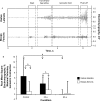Roller-massager application to the quadriceps and knee-joint range of motion and neuromuscular efficiency during a lunge
- PMID: 25415414
- PMCID: PMC4495431
- DOI: 10.4085/1062-6050-49.5.03
Roller-massager application to the quadriceps and knee-joint range of motion and neuromuscular efficiency during a lunge
Abstract
Context: Roller massagers are used as a recovery and rehabilitative tool to initiate muscle relaxation and improve range of motion (ROM) and muscular performance. However, research demonstrating such effects is lacking.
Objective: To determine the effects of applying a roller massager for 20 and 60 seconds on knee-joint ROM and dynamic muscular performance.
Design: Randomized controlled clinical trial.
Setting: University laboratory.
Patients or other participants: Ten recreationally active men (age = 26.6 ± 5.2 years, height = 175.3 ± 4.3 cm, mass = 84.4 ± 8.8 kg).
Intervention(s): Participants performed 3 randomized experimental conditions separated by 24 to 48 hours. In condition 1 (5 repetitions of 20 seconds) and condition 2 (5 repetitions of 60 seconds), they applied a roller massager to the quadriceps muscles. Condition 3 served as a control condition in which participants sat quietly.
Main outcome measure(s): Visual analog pain scale, electromyography (EMG) of the vastus lateralis (VL) and biceps femoris during roller massage and lunge, and knee-joint ROM.
Results: We found no differences in pain between the 20-second and 60-second roller-massager conditions. During 60 seconds of roller massage, pain was 13.5% (5.7 ± 0.70) and 20.6% (6.2 ± 0.70) greater at 40 seconds and 60 seconds, respectively, than at 20 seconds (P < .05). During roller massage, VL and biceps femoris root mean square (RMS) EMG was 8% and 7%, respectively, of RMS EMG recorded during maximal voluntary isometric contraction. Knee-joint ROM was 10% and 16% greater in the 20-second and 60-second roller-massager conditions, respectively, than the control condition (P < .05). Finally, average lunge VL RMS EMG decreased as roller-massage time increased (P < .05).
Conclusions: Roller massage was painful and induced muscle activity, but it increased knee-joint ROM and neuromuscular efficiency during a lunge.
Keywords: electromyography; flexibility; muscle activation; pain; stretch.
Figures




References
-
- Behm DG, Chaouachi A. A review of the acute effects of static and dynamic stretching on performance. Eur J Appl Physiol. 2011;111(11):2633–2651. - PubMed
-
- Kay AD, Blazevich AJ. Effect of acute static stretch on maximal muscle performance: a systematic review. Med Sci Sports Exerc. 2012;44(1):154–164. - PubMed
-
- MacDonald GZ, Penney MD, Mullaley ME, et al. An acute bout of self-myofascial release increases range of motion without a subsequent decrease in muscle activation or force. J Strength Cond Res. 2013;27(3):812–821. - PubMed
-
- MacDonald GZ, Button DC, Drinkwater EJ, Behm DG. Foam rolling as a recovery tool after an intense bout of physical activity. Med Sci Sports Exerc. 2014;46(1):131–142. - PubMed
Publication types
MeSH terms
LinkOut - more resources
Full Text Sources
Other Literature Sources
Medical
Research Materials

